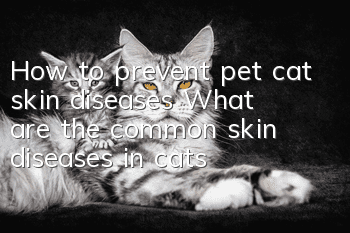How to prevent pet cat skin diseases? What are the common skin diseases in cats?

Skin diseases are one of the common diseases in cats. They not only make cats suffer but also trouble their owners. Skin diseases are easy to recur and are contagious, which is also the main reason why it is difficult to treat. Therefore, it is very necessary to prevent cat skin diseases. Not only can cats maintain a healthy body, but it will also reduce the owner's troubles. So how to prevent cat skin diseases? What are the common skin diseases of pet cats?
1. How to prevent cat skin diseases
In the process of raising pet cats, in addition to carefully caring for the cat's hair, we must also pay attention to the cat's skin health. The home should be kept clean at all times. In order to avoid bringing outdoor parasites into the room, the clothes and shoes should be cleaned slightly when returning from the outdoors. Cats should also try to avoid contact with other pet cats with fleas to prevent the infection of parasites.
Breeders should also bathe cats regularly to ensure that the cat’s hair is clean and to remove parasitic fleas and lice. Generally speaking, long-haired cats should be bathed every two months. Short-haired cats are less likely to get dirty, and short-haired cats can be bathed once every 3, 4 months or even half a year. The specific cycle of cat bathing still needs to be determined based on the cleanliness of the cat's body. When it is found that the cat's body is already very dirty, the cat can be bathed and cleaned to prevent the breeding and reproduction of parasites on the cat's hair.
In short, having healthy skin is not only what humans want. Pet cats also have the right to pursue beauty, and they also have the right to enjoy healthy hair and a healthy body. To this end, maintaining the health of pet cat fur is something that owners must and must do in the process of petting cats. This is also a prerequisite for ensuring that cats and people can live in harmony.
2. What are the common skin diseases in cats
Cat Alopecia: "Alopecia" is the technical name for bald spots. Symptoms of a cat are itching, biting its own fur, and often behavioral changes. The cause of hair loss can start from allergic reactions (such as fleas, parasites (such as lice, mites, ringworm, etc.)). In severe cases, cats will pull their own hair.
Skin diseases caused by different causes will show different symptoms and therefore require different treatments. Mites are often the culprit and can cause different symptoms. Mites do not cause itchy skin and are not contagious. It's actually a tiny species that lives inside cats' hair follicles. However, some forms of worms can cause severe itching and are contagious, so they can be spread from cat to cat. Therefore, if your cat suddenly begins to itch, especially if the scratches are severe, contact your veterinarian for treatment.
Eosinophilic granuloma: Eosinophils are cells of the immune system that helpKill bacteria. By doing so, it can also develop inflammation. Granuloma is a form of swelling where many eosinophils gather in an area in an attempt to avoid infection, but this is not always possible. This disease in cats is a disease of the skin and gums. If the plaques or swellings continue to grow, redness, swelling, erosion or ulcers will appear. The same phenomenon occurs on the skin. However, these lesions are not itchy, but they are painful. This usually occurs in young cats, most commonly between 6 and 12 months old.
Once a cat has a skin disease, it should be treated actively without delay. If there are other pets in the home, they should be isolated first. All things used by cats infected with skin diseases should be disinfected regularly, and the cat should be exposed to the sun as much as possible. Effectively helps cats recover.
- Why can't a cat urinate?
- How to fight against cat hairballs? Analysis of the causes of cat hairballs!
- Female cat develops a hard lump in lower abdomen after breastfeeding
- What to do if a cat eats foam plastic? These methods are very effective
- Why not get a short-legged cat?
- Will a cat's whiskers grow back if they are cut? What is the function of a cat’s whiskers?
- How long will it take for a stray cat to come back after being lost?
- What to do if your cat is depressed
- Cats vomit hairballs. Can the hairballs in the cat’s belly be seen during ultrasound?
- Is it normal for cats to have extremely smelly diarrhea? What is it related to?



